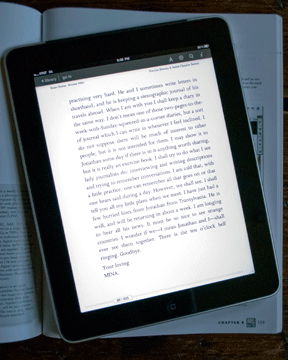By Taylor Lee/reporter
Textbooks have not been excluded from the digital age.
Students can now access textbooks not only in hard copy form but also on computers or e-readers.
In 2009, digital textbooks generated about $40 million in sales, estimates Rob Reynolds, director of product design and research for Xplana, in a 2010 report. But he expects that to double to $80 million this year. By 2015, the market will exceed $2 billion in sales, or more than 20 percent of the total market, he said.

With tighter budgets, students look for any relief possible to save money. Digital textbooks are about half the cost of print textbooks, Reynolds said.
Not every book is offered in digital format, but it is a growing trend, according to Simba Information. Students will see more digital textbooks in the coming semesters because they are becoming a more affordable, more convenient route to textbooks.
Some digital textbooks are sold chapter by chapter. This way, the student can purchase the chapters the class will cover.
With the environment as a concern with print textbooks, some students finishing the semester go to sell back the books they will never touch again and discover the bookstores won’t buy them back. So the books either sit around in boxes for years or go to local secondhand bookstores.
Digital textbooks help the environment by not cutting down as many trees as needed for paper for the hard copies.
On the negative side, digital textbooks cannot be sold back at the end of each semester unlike most print textbooks.
Students normally carry around quite a few pounds of textbooks in their book bags, so digital textbooks would lighten the load. If students needed pages from a book, they can just print the pages they need.
“I have taken online classes where I have used the online version of my textbook and what a great tool,” student Sonja Silva said. “There are times when it is not convenient to carry regular textbooks with you.”
With digital texts, students can enlarge and shrink text for their viewing preferences as to how much of the page that they would like to see and can zoom into charts, maps and other images.
E-readers and computers are needed to view the digital textbooks, and initially the cost of buying these devices is higher than print textbooks. The purchase eventually pays off since the actual download is about half of the price of a hardback textbook.
Students can also use searches to find particular items in a digital text, rather than having to depend on the index in a hard copy.
“I love the convenience of digital textbooks when I can get them,” student Evan Chandler said. “I love that I can do a text search for something I’ve read. It’s really awesome.”
With the technology, of course, comes difficulties and issues when books do not download properly or if students have a computer problem.
“I don’t like digital textbooks. My hard drive crashed earlier this year, and I lost a book,” student Erin Tate said. “I’d much rather have the hard copy in my hand.”
Students also may find that different e-readers carry different digital textbooks. For example, some may be available on the Kindle but not on the iPad. In the coming years, though, experts believe digital textbooks will be more readily available.
“With the advances in technologies, it would seem that this is the future,” Silva said.



























